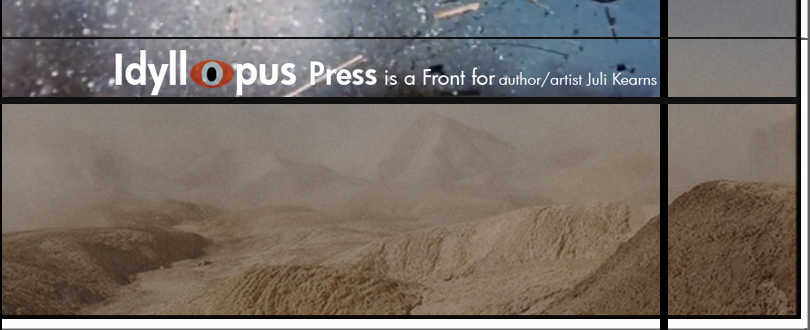MICHELANGELO ANTONIONI'S ZABRISKIE POINT

Go to Table of Contents of the analysis. Antonioni's films are rife with themes, peculiarities and incongruities which largely go unnoticed due his deft care in handling them and the abundant and rich audio and visual textures in which he immerses us, but they are also responsible for the sense of mystery that defies a traditional expectation of resolutions, infusing Antonioni's films with enigmatic mythic purpose. And myth is never hampered by logic.
PART TWO
TOC and Supplemental Posts | Part 1 | Part 2 | Part 3 | Part 4 | Part 5 | Films Home
LINKS TO SECTIONS OF THE ANALYSIS ON THIS PAGE:
What Kind of Bread Do You Want?
Some Ghost Town
What kind of bread do you want
283 Extreme lose-up of Mark's face shielded with sunglasses, his head down, through green light.
284 Medium shot of Mark seated on a bus, the green revealed to be its tinted windows. The green tint is flashed with an occasional touch of red from outside the bus.

285 Close-up then of Mark, natural tones, the green window behind, the bus driver announcing "Rockway and Curvy (?), end of the line."
286 Medium shot of Mark exiting the bus. We see a 7 Up sign outside it.
287 Long shot of Mark outside the bus.
As Mark exits, following after a woman in a bright red dress (this bright red color had been swallowed on the bus by the green tint) we see outside the windows a 7 Up sign and Seaside gas. The bus is 5847. Two benches at the bus stop have on their rear advertising for mortuaries. "Dunaway and Douglass, Hawthorne's Preferred Mortuary" and "McCormick Mortuaries, Inglewood, Hawthorne, Westchester". The bus pulling away, we see in the background on a truck an older gray car much like the one that Daria is driving. A Standard gas station sign is beyond that. A woman in a burgundy dress with white polka-dots enters the frame from the right.
Okay, to return to the squirrely Green Horn/Green Hornet (which comes from "horn") puns I discussed in section 2. To refresh, (1) In shot 157 Antonioni zooms in on a green neon sign for guns-archery outside the gun shop, then in the next shot in the foreground is a horn (musical) hanging next to a pole in a shop that is otherwise all guns. After that single shot, we don't see the horn again. (2) Shot 253 shows a Bruce Lee graphic on green paper, and I was guessing it referred to him as Kato in the TV show "The Green Hornet", superheros with dual identities.The Green Hornet was on police books as a real criminal but in real life he only pretended to be one in order to infiltrate gangs. This would remind activists of things like COINTELPRO. (3) Now we have Mark on the bus shot through a green filter (I guess as if from outside the window though the shots are close-up and a medium shot, and then there is a shot of him in natural light sitting beside the green-tinted window. Where is the horn? Well, it has to do with their being in Hawthorne. We see, as he disembarks, two benches, both advertising mortuaries (death) and thus Hast-horn-e. One is stated as being at Hawthorne, Westchester. If we go back to shot 157 the camera, zooming in on the green neon sign had also shown behind it a Winchester rifle poster.
I had said all this made me wonder as to Mark's role in the film. Did we have reference to the greenhorn, like a young ox, which would fit in with (themes continuing from film to film) The Passenger in which Antonioni identified with David Locke/Robertson with the bull in a bull fighting ring? Or does he only appear to be a clueless, pointless activist when instead he is agitator/informant, then something breaks down and he moves over into his pretend role and becomes the activist he'd been pretending to be, which would fit with the journalist character in The Passenger who takes up the role of being the illegal gun dealer and becomes that person, David Locke becoming David Robertson.
There are a couple of other things. When he runs the stop light at Sunset Boulevard (where is the sign for Benedict canyon), he almost causes an accident with three other cars, but none of those cars honk at him. This stands out. When a woman waves at him he says she's from his long gone past, a sister. Whoever she is, she is someone outside the activist group. Then when Lee Allen is up in his penthouse office at Sunnydunes, concerned about Daria's whereabouts, before he has his secretary dial her, he makes a brief call, during which time we hear clearly a horn honk outside, and then he puts the phone down. I've wondered if somewhere in there we don't have a green horn/green hornet connection, because of the obviousness of the horn heard up in the penthouse high above the street, in contrast to no horn being sounded when there should have been during the near accident. But where's the "green" in Lee's office to go with the horn? I reasoned it was perhaps the large cactus, that its arms could be perhaps thought of as horns. Still, it seemed to me there should be some horns. In shot 346, back at Lee's office while he's speaking with Daria on the phone, we will see beside the cactus the statuette of a stag (buck) with large antlers which perhaps suggest horns. I don't know about that one, antlers and horns not being the same thing. Or the horn could be there by the virtue of the cactus having t-horns, and the stag with its antlers reinforces at least with a horn-like image.
Going back to the mural of the pigs, one standing apart on the roof, and the talk in the activist meeting of pigs being in campus and in meetings, we could then see Mark as the isolated agitator/informant pig on the roof. His urgency as far as getting guns could be to plant guns with the group to get them further into trouble. He doesn't protest but when he shows up at the police station he takes pains to make himself obvious and get himself arrested, further identifying himself with the movement as an ally. When he rushes down to the school he stands beside a Liberal Arts building, and Bruce Lee is in martial arts. This is perhaps another connection as far as dual identities. He hides from both the police and protestors. After the officer shoots the Panther, he goes to pull his gun from his boot, but then the officer is shot and falls and Mark ducks his head in a manner that could be taken also as being concerned and agrieved. When he flees it could be because it's a matter of it being essential he maintain his cover. But then something happens along the way and there's a confusion of identity. He takes off in a plane (which he obviously knows how to fly really really really well) and later tells Daria he had to get off the ground. Again, return to the mural of the pigs with one of them standing apart from the others on the roof. And it may explain why he doesn't "turn on", having been part of a group on a "reality" trip. Though, turning on wouldn't have been a problem with narcs.
So, it's very possible we could have heree both the idea of the greenhorn as well as the inside agitator who becomes his role, just as in The Passenger. There is certainly a connection between the green portrait of Bruce Lee and Mark being filmed here with the green filter.
288 Cut to a little futher back, the camera still on Mark and the woman in the burgundy dress with the polka dots.

289 Medium shot from behind Mark.
Mark is observed then walking toward a car sales lot and a Bank of America sign showing a setting sun receding behind hills. This setting sun is nearly identical to the one on which the film will end. We've already seen in the Sunny Dunes offices a model for a billboard with what is perhaps the Sunny Dunes logo, a bright red sun setting over high hills or mountains.
He cuts to the right.

290 Medium shot from behind of Mark walking past the parking lot.

We see a curious duplication of a bank billboard on the left, to do with "new checking plans". Perhaps another Bank of America ad. And beneath it is another billboard with the same 4 figures, a man, older woman, younger woman, older man, but there is no script on this board, only the picture. No words. In the distance is an ad for "Challenge Cottage Cheese" and a sandwich spread.
This ad showing the four individuals, then reframed to show them in close-up, with no text, I take to be partly a commentary on the style of editing technique Antonioni is utilizing in the film. As I've previously noted, he will have a shot followed by another in which we don't have a change of perspective really, but instead we may be only moved in slightly closer, as if there's a brief ellipse. An example of it is had when Rod arrives at the Sunny Dunes building and we have a slight change in distance in shots 209 and 210. This isn't the best example, actually, for there are other shots when the change in distance from the subject will be but a couple of inches, same perspective. It is all part of, however, a very deliberate technique which has not only to do with flow, the technique in itself informing on communication of information.
These two billboards follow immediately after our having seen the Bank of America billboard showing the setting sun, which is a similar shot to one at the film's end showing the same setting sun, but supposedly in what we take to be Daria's real life, just after a fantasy of Lee's house exploding.
In the next shot we see the pilot of a boat with a woman before the pilot's wheel. It's an alcohol ad for Old Charter. This also will be replayed in Daria's life, in Lee's house, during their last conversation together. He's directing her down a flight of stairs to her room, and as she gazes up at him he places his hand on the pilot's steering wheel of a boat that is installed at the height of the stairs. Behind Daria's head will be several porcelain dishes showing images concerned with sailing ships. Here, in shot 287, the ad shows the couple with the man's hand on the steering wheel of the boat. In "real life" we will instead see Lee's hand on the wheel. It is a form of a "blow-up". Just as with the checking ad we have a wordless/textless "blow-up" of the faces in the ad above it. Just as we have so many shots in the film with a cut to a slightly closer view, a "blow-up".
All these blow-ups need to be considered as regarding the scene of the explosion, which is itself a blow-up.
291 The camera then shows us Mark passing the side of a building covered with a 7 Up ad along side one for "Old Charter" bourbon, a man and woman piloting a boat with, again, a red and gold sunset as background.
The "Fresh Up with 7 Up" is a play on Mark Frech-ette taking the Lilly 7 and sailing up into the sky.

292 Medium-long shot of Mark before the store.
Rounding the corner to the front of the store, we see a hitchhiker. A mechanic in white overalls exits the store with a bottle or canister of some type in his hand and promptly, intentionally drops it in the street's gutter as Mark passes, then the mechanic simply walks off.

293 Medium shot of Mark entering the store, from inside
Mark enters the store passing a wall covered with comic books and alcohol. Another 3d ad for perhaps Old Charter bourbon is placed front and center of the camera, dominating the scene, a woman and man on a red sailboat, orange and red hues of the setting sun behind them. Outside had been the Old Charter ad with text. Inside is this other version with Antonioni only showing the image. No words. The boat and water motif that enters continues to the film's end.
Next to this are blue and white cans of Iris products. The first reads baby kosher pickles with no image, the next can is the Iris brand that shows oranges and a glass of orange juice but no identifying text for what the can contains. Again, we had the ad or brand with text and then no text, no words. Beyond or more cans of Iris products showing both images and text: orange juice, fruit cocktail, tomato juice. We hear it being asked what kind of bread is wanted.

SHOPKEEPER: What kind of bread?
294 Low medium shot from behind the counter of the shopkeeper and two customers, Mark approaching.
CUSTOMER: I don't know. Hero bread.
CUSTOMER #2: Make mine rye. A lot of mayonnaise.
We see the shopkeeper behind the counter making sandwiches for two individuals in white mechanics uniforms, one of which has a name on it and the other not. Above them are numerous ads for coke. A giant cigarette spews plastic smoke. "Hero bread," one of the workers guesses. The other asks for rye with a lot of mayonnaise. Mark squeezes between them to reach the payphone located in a small end nook with yet more coke ads and ads for alcohol, Schmidt's, Smirnoff, Country Club, the camera panning to follow him.
295 Medium close-up of the two customers.
296 Medium close-up of Mark from behind.
297 Close-up of the hands of the shopkeeper as he makes the sandwich, laying on the meat.
CUSTOMER #1 (off screen): Why so light on the meat, Bob? I ain't on no diet.
SHOPKEEPER (off screen): If you want extra, ya pay extra.
CUSTOMER #2 (off screen): We're paying, don't sweat it.
The shopkeeper sprays oil on the out of a diner style squeeze bottle with nozzle spout. Antonioni granting a pointed close-up of this mundane motion, I realize that it continues the motif of the fire hose, the garden hose that was spraying water on the camera.
298 The mustachioed friend of Mark's answers the phone.
Cut to Mark's roommate diving to answer the phone in the bedroom of the house where we'd earlier observed them.
MARK'S FRIEND: Hello.
MARK (off screen): Hi.
MARK'S FRIEND: Where are ya?
MARK: Hawthorne.
MARK'S FRIEND: You better cool it. Somebody called and said you're on TV. Was it really you?

MARK: What?
MARK'S FRIEND: On the news.
295 Close-up of Mark at the phone.
MARK: Are you sure?
MARK'S FRIEND (off screen): He said the guy looked just like you.
MARK: Morty...
Mark turns and looks at the others in the store.
299 Medium shot of Mark's friend seated on the bed. Through the open window we see an older black couple, a man and woman standing before a white building below.
MORTY (standing): Hello? Mark? Hello?
300 Medium shot of the shopkeeper and workers, Mark standing beyond, away from the phone.
MARK: May I ask a favor of you.
THE SHOPKEEPER: Sure, shoot.
And despite his having likely heard the worker being denied more meat unless he paid for it, despite his face now being apparently premium news (or a face that looks like his), despite the fact he might want to keep a low profile, Mark brings further notice to himself by asking the shopkeeper if he will trust him for the price of a sandwich.
301 Close-up of Mark.
MARK: I was wondering if you'd trust me for the price of a sandwich.
THE SHOPKEEPER (off screen): It's not that I don't trust you personally, but if I trusted you then I'd have to...
302 Close-up of the shopkeeper.
THE SHOPKEEPER: ...trust everybody in the whole world.
299 Close-up of Mark.
MARK: Yeah.
303 Exterior. Shot of airline ad.

Medium shot of a large wordless ad showing passengers on a plane, the camera panning left to show beside it an ad for Best Foods Sandwich Spread. The camera zooms back to show Mark looking at the ad.
We had briefly seen this ad from inside the store and above the image were the words "Jet Delta to Dallas...Most Non-Stop..." So we know it has script but for all intents and purposes Antonioni has converted it into a wordless sign, just as he had done with the dual ads showing the 4 individuals, one of which had the ad text, the other which didn't. No words.
We hear a plane.
304 Switch now to a front view of Mark seated before the Seaside gas station at the foot of a giant fiberglass statue of a muffler man between whose legs is an official smog inspection station sign.
After a moment Mark rises and wanders past the little grocery store's pink front.
305 Medium shot from behind Mark.
Coming to the corner he looks up and sees an airplane flying above, which passes behind the earlier mentioned dupe of the bank billboard ad. Buried beneath it is a restaurant parking sign which is largely obscured.
Much is made of the signs in the film as representing Antonioni's contempt for American consumer culture but, as I've written above, much more is involved.
The first sign we see in the film happens to be at the activist meeting, the upside down "Join Us" sign. I was reminded of the signs at the protest march in "Blow Up", which looked to be only a protest march against nuclear armaments (expressed in only one sign by a mushroom cloud or really "Blow Up") but more was involved as one of the signs read simply "NO, NO" and another read only, "ON, ON". One could say it was an accidental reversal but I don't believe it was. Another of the signs read "Go Away", during a scene in which the photographer was being stalked and so was more a commentary on the immediate situation rather than nuclear armaments. Who was being told to go away is another matter. Signs led us through that film, led its protagonist. Signs lead us here as well and comment on the situation in often cryptic ways, foreshadow, and teach us to look beyond the words to the images themselves being signs communicating information.
So, the first sign was the "Join Us" sign at the meeting, which was upside down and an "On Strike" sign beside it. In the next scene, the only observable sign was the one we could only see partially, a man's jaw (resembling Rod Taylor's) and the word "Key" below it, which was followed by Rod Taylor appearing and the camera showing this in combination with the security guard's keys. Then, in the third scene, we saw the cow (Federally Inspected Meat), and the Farmer John's pig sign (though no words) followed by the onslaught of signs experienced during Mark's drive through the city on the way to the picket line.
How does he respond to the signs? Well, he evidently ignores the "Join Us" sign, which is commented on as being bourgeois independence which will get him killed (that is if he is not an agitator/informant/turned activist). He ignores a stop sign on the way to the picket line and runs it. When he leaves his house to go down to the strike we see he has ignored a "No Parking" sign.
Mark now follows the signs encouraging flight.
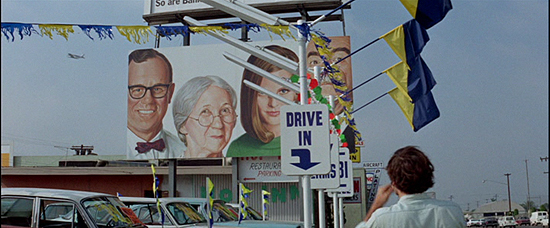
306 Shot of Mark with hand to his eyes, gazing at the sky.
Red and green car dealer windmills circulate before the camera, the color red furiously predominating as a police siren is heard in the background.
307 A painted family in red shirts stares down expectantly at Mark from the crown of the Statue of Liberty in an ad for "United to New York, Let's get away from it all."

308 Medium shot of Mark walking before the UNITED ad.

309 An airplane passes behind a building and flies to screen right.
310 Medium close-up of Mark crossing a street.
Mark follows an incoming plane across the street to a small airport, several smiling black women in a light yellow colored auto having to screech to a halt as he's jaywalked out in front of them.
311 Mark approaching Bates Aviation as the yellow car passes.
312 Shot from inside the airfield's fence of Mark passing a boy on his bike and entering an open gate.
313 Two men in an airplane's cockpit.
314 Close-up of Mark looking at the plane.
315 The plane firing down.
316 Long shot of Mark passing the jet.
317 The jet's door opens. Two businessmen in brown suits exit and walk past Mark.
318 Close-up from behind Mark of him walking the pavement to another plane, the Lilly 7, which rests beside the large jet which has just flown in.
319 Long shot from above of Mark walking around the front of the Lilly 7.
320 Medium shot showing the driver's door of the Lilly 7 is open, Mark approaching.
Out of all the small, private planes, the door is open and unwatched to the "Lilly 7" which is a pale pinkish-cream color decorated with pink stripes. N6835R.
The "7" of the Lilly 7 is foreshadowed/repeated in the occasional focus on the "Fresh up with 7 Up" ads. Later Mark will be asked why he stole the plane and he will say he needed to get off the ground. 7 Up. And it's an amusing little coincidence that Mark's name is Mark Frechette as in Fresh.
A propeller belonging to either a plane or a boat was an outstanding object in Blow Up. It was found in an antique store after the fateful event in the park, the making of the photographs which will later be blown up and up and up to reveal the dead man. Thomas had said he couldn't live without it but when he attempted to put it in the back seat of his car the owner of the antique store had protested his car wasn't a delivery van. It was on his way home from this, after a business meeting, that he passes by the protesters, one of whom put the "Go Away" sign in the back seat of his car. The sign had blown out of the back of the car.
A sign in the distance for American Federal shows money blowing up and about in the wind.

The American Federal sign reminds of the Desert Springs "You Are What You Eat" billboard with the money in the salad bowl before which Daria had briefly parked in the desert in order to look at her map.

321 Medium shot Mark climbing in the plane.
322 Mark straps himself in with the red seat belt, starts the plane and begins to taxi.
323 Medium shot of the control panel.
The camera pans around to show a mechanic in a white Bates uniform who comes running forward.
MECHANIC: Where do you think you're going?
324 Medium shot of Mark from behind the mechanic.
MARK: Just a little scenic flight. Wanna come?
MECHANIC: No, thanks.
MARK: Okay.
325 Medium shot of Mark through the front windshield as he taxis the plane over the pavement and down a runway.
326 Medium shot of flight controllers.
The flight controllers yelling at him to abort flight. He narrowly avoids a collision with an incoming plane and is as unconcerned as he was when he ran the red stop light.
327 Shot of Mark from exterior the plane's cab, he having taken off, rising above the streets.
As he soars into the air, the city becoming smaller and smaller beneath him, he smiles and the spare music track gives us a clip of the Grateful Dead's "Dark Star".
328 Aerial shot of a green field below cross-crossed by dirt roads, surrounded by the suburbs and industry.
329 Shot of Mark in the plane.
330 Aerial shot of a clover leaf of an interstate over which he soars.

Check it against the highway we were given the earlier aerial of where Daria exited to look at the map, confused as to her location.

The "You are what you eat" salad bowl of money had appeared in conjunction with the partial cloverleaf interchange in Daria's scene. With Mark, it appears immediately before he takes off from the airport and the similar interchange is shown.
331 Shot of Mark in the plane.
332 We see next two stadiums (circular and oval) beside one another.
333 And then another view of the interchange which is shown now as a double cloverleaf.
334 Mark in the plane.
335 Aerial shot of the city and beyond it a brown smog suggesting also the desert, as if it is just beyond.
336 Aerial shot of sand dunes.
And with the next shot we indeed have what at first seems to be Mark soaring over the pale brown-tan of the desert, his path intersecting with Daria's car below, but instead it simply turns out to be an aerial shot.
337 Medium shot of Daria, from the left, driving the car.
Daria eats an apple as we hear Pink Floyd's "Crumbling Land".
...in a smile I saw a single eagle in the sky
wheeling, soaring, gliding high.
The full lyrics are:
In a while, I'll find the time to make the sunshine mine
In a smile, I saw a single eagle in the sky
Wheeling, soaring, gliding by
On a hill there lived a man with many shining things
Shiny pool, shiny car and shiny diamond rings
Wining, dining, shining king
And the eagle flies in clear blue skies
Breathing in the clear blue air
Back here on the ground another dealer coughs and dies
And fifty more come rolling off
The Ford production line
Then a man appearing like a mirage on the sand
In his hand a moving picture of the crumbling land
Screaming, dealing, movie man
Here we go, hold your nose and see if something blows
Close your eyes, count to ten and see the sunrise rise
Climbing high into the sky
By the ornamental lake a diamond lies
Upon the finger of the king
On high, the eagle spies the glitter of a gun
Then wheeling in a climbing turn he flies into the sun
338 Aerial view of Daria's car.
Some Ghost Town
339 The conference room at Sunnydunes, one of the executives on the phone, standing before an image of Phase II Future Development.
We hear being said in a meeting, "Well, I don't know, are we satisfied with the cost projections in the first phase?" And the response, "Steve can answer that."
The executive, saying, yes, yes, raises the phone, nodding to someone that it is for them.
STEVE (off screen): Ah yes, we've funded for two hundred million, set aside 40 against contingencies.
LEE (called to the phone, as he takes it): Wait a minute, why tie up 40 million dollars for contingencies? What, what contingencies?
EXECUTIVE WHO ANSWERED THE PHONE (sitting): We found certain areas where there are differences in the water table. Soil tests have shown density factors that increase...
LEE: Hello. Hold on a minute. I'll take this in my office.
Realizing it's Daria, Lee says he'll take the call in his office. We have had a glimpse of his wristwatch which reads 12:30.
EXECUTIVE (off screen): We haven't been able to figure accurately the cost of blasting rock slopes.
EDIE (female executive, off screen): When will we have the exact figures.
The camera has panned to follow Rod Taylor to the door of the conference room which he exits.
340 Long shot of the conference room and the executives at the table.
ANOTHER EXECUTIVE: Oh, Edie, we can't make exact estimates until Phase I is 65...
341 Medium close-up from behind Daria of a counter.

Cut to Daria looking at a framed, faded picture of a young soldier in the jungle in Vietnam, his baby picture and a picture of him in a baseball uniform also stuck in the frame. The young soldier is scarcely more than a boy.
A clown figure on stilts stands alongside the framed photo. A black vase with white plastic flowers reads in part, "Lay...This is...the Old...Priv..." Plastic toy miniatures of horses stand beyond. We see another large vase holding plastic flowers, the ceramic of this vase inset with buttons and stones from costume jewelry.
342 Medium shot of Daria before the counter.
A cut has been made to another shot of the same scene with almost no change in perspective, just a slight move to the left.

The camera zooms out slightly but gives us almost no real opportunity to view one of the artificial flowers in the vase is a white lily. Perhaps the boy in the picture frame has died in Vietnam and the lily is a memorial. Perhaps this white lily refers to Mark in the Lilly 7.
Returning to the photo of the boy in Vietnam, with at least one arm raised (sometimes it looks like two), I'm going going to look back at another scene in which we had these raised arms.
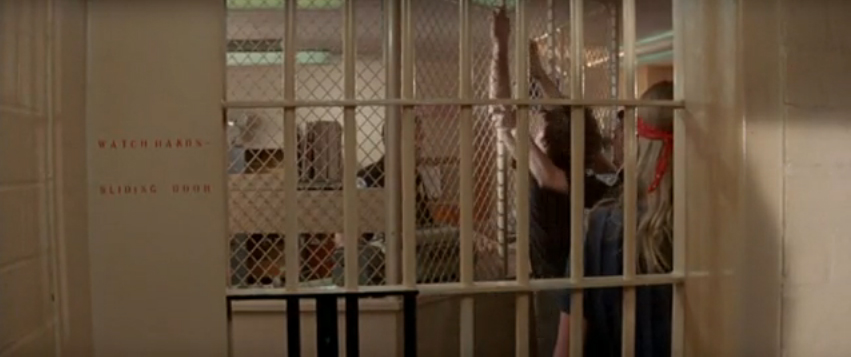
Back at the jail, Mark makes a show of getting himself arrested. Antonioni again has an "instruction" first (in a sense) followed by an image. We have above the sign saying "Watch hands..." and then we have Antoinioni watching Mark's hands.

So, just as far as style. There is the instruction "watch hands", and the text cue that is then eliminated, no longer needed, when we see Mark's hands next. Another form of, say, the ads which first have text and then appear again without text. This is not that different.
As far as story, I have wondered about Mark's flying ability with the plane and wondered if this might suggest flying experience in Vietnam. Antonioni placed such an emphasis on Mark's upraised arms, I wondered if there could be an attempt to establish a visual connection with this soldier.
343 Medium shot of the phone on Lee's desk, he advancing to pick up the receiver.
In his office, Lee approaches his desk on which rests a report titled "Alpine". Picking up the phone he asks Daria what's up and where is she.
LEE: What's up, Daria? Where are you?
DARIA (off screen): I'm in some ghost town. I just called to say I might be a little late to Phoenix.
LEE: Why?
344 Long shot of Daria at the end of a long bar, a painting of cattle grazing on the wall.
We see the POOL ROOM sign in reverse through the window, partly covered with a curtain, so it reads LOO MOO. Moo reads at first glance as perhaps intentional to go with the picture of the cows, but is actually going to go with OM and her being here, as said, for "meditation". For more on this please see the end portion of my analysis on The Passenger, for this is a motif found in Blowup and The Passenger as well and makes the most sense when viewed in the way Antonioni works with it through these three films.

DARIA: I'm looking for a little town that sounds something like Glenville or Ballyville or something like that, something with a ville in it. You know the desert, does that ring a bell?
345 Medium shot of Lee in his office.
LEE: A ville? A ville? Wait a minute, hold on.
Lee puts her on speaker and goes to an atlas.
LEE: A ville. What do you mean, like a Danville?
DARIA: No way, in the desert. Danville's in Connecticut. Or maybe it's hill? Something hill.
LEE: Hill, hill. Well, what do you want to go to a town you don't know the name of for? Have you got somebody to meet?
DARIA: My friend said it's a fantastic place for meditation.
Fort Hill was the name of the commune run by Mel Lyman where Mark Frechette lived, in Boston, and to which he returned with Daria after the making of the film. I read he tried many times to encourage Antonioni's interest in the commune.
346 Another view of Daria shows on the opposite wall the picture of a screaming mountain lion.

The lion recalls the momentary flash of the image of a mountain lion in the Sunny Dunes commercial and the slaying of the Black Panther.
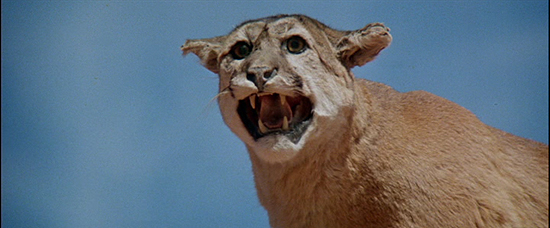
We see postcards on a stand but none of them gives a clue as to where she might be, one of them reading "Colorado" and another showing Saguaro cactus.
LEE (off screen): What do you do on a meditation?
DARIA: You think about things.
347 Medium shot of Lee in his office.
LEE: You think about...Daria, look, give me the number you're calling from and I'll try to find out the name of the town and call you back, ok?
348 Long shot of Daria again at the end of the bar in a pool room.
DARIA: Oh, no, you'll probably have a helicopter sent out here to pick me up.
349 Close-up of a small hinged board on the wall beside Daria that reads, "In case of FIRE raise this flap," three stick firemen below holding a spraying fire hose, one with an axe, which brings to mind the fire hose before which Mark had been standing in the meeting, and the hose in the commercial film.

LEE: Come on, Daria.
She raises the flap and laughs when she finds it reads, "Not now, stupid. In case of fire!" She laughs.
OPERATOR: Thirty cents, please, for the next three minutes.
350 Medium long shot of Lee in his office.
Notice the clock, prominently displayed on the monitor, seeming to display the time as 3:05, and then sliding to show another measure which could be temperature or barometric pressure.
LEE: Just a second, operator. Look, give me the number then hang up and I'll call you back and that way I can pay for the call.
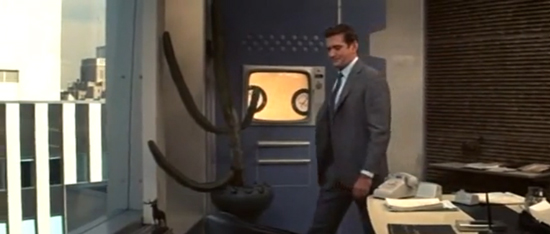
351 Medium close-up of Lee and the street below outside the skyscraper, a hint of desert beyond, as if he could possibly, from his Olympian height, see across California to the desert in which Daria is lost. We see a "Udrive" sign next to a parking lot.
DARIA: See you in Phoenix.
She hangs up. Taking a drag on his cigarette, Lee turns, exasperated, to look out the window.

352 Cut to an old man at the bar, dressed in a plaid shirt and cowboy hat, a beer before him, taking a drag on a cigarette. The owner stands behind the counter drawing a beer for Daria. As she sits at the counter before her hamburger, beside the old man, we see a pool room beyond. Daria asks the old man if he knows of a place called Glenville or Ballyville or something like that. He shakes his head no.
DARIA: Say, do you know of a place around here called Glenville or Ballyville or something like that?
OWNER (hearing and responding instead): Ballister?
DARIA: That's it.
353 A shot of the owner in the doorway leading from the pool room to the cafe, a red neon circle of a sign in the far window haloing his head reminding me of the circlets of radishes in the salad bowl ad. Beside him is a stand of pocket watches.
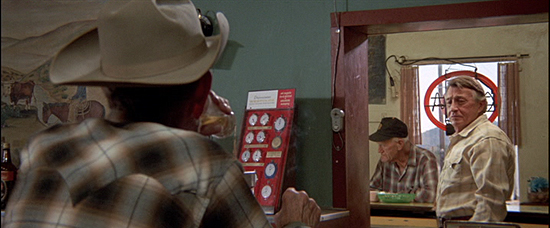
OWNER: Sure do, you're standing in it.
DARIA (off screen): Oh, yeah?
OWNER: You didn't come here to see one James Patterson, did you?
354 Medium close-up of Daria beside the old man with the cowby hat.
DARIA: How do you know?
OWNER (off screen): You look like the type.
355 Medium close-up of owner.
OWNER: Well, you can tell him for me he's going to be the death of this town. He's going to ruin a piece of American history.
356 Medium shot of Daria at the bar beside the older man with the cowboy hat.
DARIA: Jimmy?
The owner leaving the bar area, she follows him to the other side of the wall where there is a lunch counter.
357 Medium shot of Daria entering the lunch counter area.
A "Frostie" sign is the most conspicuously placed ad among the few observed. As she walks around the lunch counter an old, toothless man wearing an SF cap reaches out and stops her.
OLD MAN: Do you remember Johnny Wilson?
DARIA: Johnny Wilson? No.
OLD MAN: That's me. I was middleweight champion of the world in the 1920s.

DARIA: Middleweight champion of the world?
OLD MAN: That's right
The Tennessee Waltz music begins.
DARIA: That's great.
OLD MAN: Thank you.
I've seen a photo of Johnny Wilson as an older gentleman, and I've inset it next to the "Johnny Wilson" of the film. He had a very large and broad nose (even as a young man, which would have only become larger with time), a round face, and his chin was not nearly as long as the individual's in the movie. I would be pretty surprised if this person with Daria is speaking is Johnny Wilson, and he's not credited at IMDB. He was an east coast guy, living in Boston in the 1970s, and, from what I read, had done well for himself. He wasn't down-and-out. He wasn't an old westerner in a San Francisco Giants baseball hat sitting in a pool hall in the desert southwest.
This fits in with the theme of aliases and doubles (which appears in so many of Antonioni's films) but one wonders why Johnny Wilson? Is it because the name "Johnny Wilson" was an alias, and his real name was Giovanni Francisco Panica? The Francisco would fit with the San Francisco Giants baseball cap.
I read his career was marred with rumors of fixes and corruption as his manager had ties to organized crime. He also later managed the Silver Slipper night club, the Gilded Cage nightclub, owned and operated a bookstore, and owned the Swanee Grill.
Peculiarly, Swanee is later referenced in the film. The Swanee (Suwannee) River is the well known subject of Stephen Foster's "Old Folks at Home", sung by a blackface troupe. And then there's Gershwin's "Swanee" which is said to have been originally written as a parody, but was performed in blackface by Al Jolsen. It also refers to the "old folks at home".
The Rumpus Room pool hall's customers are all "old folks", but for Daria.
I would think the "black face" is also a reason why Swanee may end up being referenced. Zabriskie Point's plot may contain concerns about racial relations, just as do so many of Antonioni's films, but he also used black/white in a more metaphysical sense, and I don't mean in the confused, stereotypical way of "black" being submerged shadow aspects that were thus threatening and dangerous, though he may have shown this stereotypical, paranoid view in his film. We do, however, have dual identities. Mark later states that he once was black but it didn't work out. But the black is incorporated again later with the plane in which he is "killed", the cone painted with the face of a human/animal black panther, but it is black face, the white showing underneath.
In The Passenger Antonioni takes pains to instruct on looking for intentional pareidolia in the landscape, showing rocks which can be seen as faces during dialogue on these invisible men who live in the desert, guerilla fighters for whom David Locke is looking. There's a scene in which he's speaking with the gun dealer (whose identity he later adopts) and the gun dealer is showing his appreciation for the desert landscape. David says he prefers people. The gun dealer, whose name also happens to be David, says there are men in the desert, at the same time we see, by intentional pareidolia, a man's face in a white stucco wall, reflected in a window. This is a significant scene, this reflection replayed at the end when we can barely see the face of the black individual, reflected in the window of room of David Locke/Robertson, who supposedly kills him. Yet we don't see him kill him. We hear the shot, but don't see it. I'll speak more about this later and how it connects with this movie.
At the Rumpus Room in this peculiar mirage of a place in the desert, a "Glenville of Ballyville" becomes a Ballister, we have doubles and illusions. Nothing is what it seems, though Daria doesn't know this. She has no reason to question whether or not this man is Johnny Wilson--and neither does the audience, the majority of which would have never heard of Johnny Wilson and would have no idea he ran a Swanee Grill.
By the way, if you look for Ballister, you will not find it. It doesn't exist. The entire time Daria is in the desert, Antonioni carefully expunges from view nearly anything that would give a clue as to where she is. Except, of course, for Zabriskie Point.
358 Medium long shot of the owner stepping behind the counter.
The owner carries a coffee cup the same color pink as the Lilly 7.
OWNER: On account of being a do gooder. He brought these kids out here from Los Angeles. Said they were sick. Emotionally sick. You know what that means?
"The Tennessee Waltz" has begun playing in the background.
Daria shrugs.
OWNER: Well, if Los Angeles don't want 'em, why should we want 'em?
359 Cut to a shot of the yellow wall on which are taped numerous cards, including a paper version of the "In case if fire!"
At that moment something crashes through the window.

The hole is high in the door, but the next shot shows it as low. We first see first something crashing through the upper part of the door, then the next shot shows the hole is now in the low part of the door and the area of the initial crash is covered by an ad dangling from the door frame, that ad swinging with the force of the crash.
360 Long shot of diner and its counter looking toward the window.
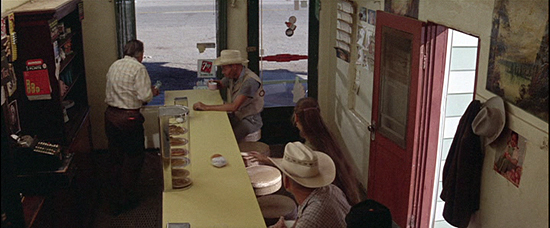
OWNER: God damn it!
The owner grabs a bottle from behind the counter and rushes to open the door, passing a small 7 up ad, and exits onto the porch.
361 Shot from the left of the owner rushing out onto the porch, Daria following.
OWNER: Goddamn criminals, coming around here again and I'm s...
362 View of the street and a bottle he throws breaking to glass smithereens on it. Note that it explodes in the street before an ad composed solely of a bottle.
His voice trails off as he throws his bottle which breaks in the middle of the street. He was about to say, "I'm sick", which is how he has described the children who have been brought here.
The breaking the bottle connects with the earlier grocery store with the 7 Up sign, from which emerged a worker in a white uniform, a mechanic, who dropped a bottle in a gutter for seemingly no reason as Mark approached, which we can see now in this repeated motif is a form of explosion, or a blow-up, which connects also with the owner of the Rumpus Room having just blown up in a rage.

Dust radiates from the crash of the glass, reminding of the smoke from the tear gas canister back at the protest. We are afforded a brief view of the "ghost town" embraced by mountain ridges, the only seeming inhabitants being those in the cafe/pool hall, and one wonders where they live in this waste populated by a few empty hulls of decrepit buildings.
...when an old friend I happened to see.
I introduced her to my loved one,
and while they were waltzing,
my friend stole my sweetheart from me.
363 From the left, the owner and Daria out front of the cafe/pool hall.
OWNER: Well, I guess you see for yourself. That window cost me thirty bucks.
He steps back inside and we get now an exterior shot of the place, "Rumpus Room" and "Market" painted on its front, a fiberglass cow advertising ice cream situated on the roof. Daria's car, curiously, is the only one outside though there are 4 other customers inside the building.
Mark, hearing that the protesters were to be forced out, had gone down to the college to see for himself, and here Daria is told she can see for herself, at a place called the Rumpus Room, rumpus meaning riot.
364 View of the Rumpus Room.

I remember the night and the Tennessee Waltz,
now I know just how much I have lost...
365 Medium shot of Daria, from the front, now across the street, examining something intently.
366 View of rips in a remnant of brown canvas wrapped around the shell of a crate, eyes peering out at her. They're five children.
367 Long shot from Daria's right of her peering at the children behind the shell of the wooden crate.
As she approaches, one of them pops, with a bang, a plastic bag, and they run off, she giving chase.
DARIA: Hey, hey, listen!
The plastic bag popping with a bang connects with the earlier gunshots at the strike.
368 Medium shot of Daria gazing after the children.
369 Shot of Daria crossing a street toward the overturned and abandoned hulk of a gray car.
Daria stood beside a white pole reading, "Old Parker Rd." looking after them, then follows across the street to an overturned gray car under which some children are hiding. Next to this is a boy in a white t-shirt plucking on the strings of a busted piano--which beomes the music for the film at this point, Patti Page's Tennessee Waltz having faded out. The children under the car throw a rubber hose, probably a radiator hose, at her as she nears.
The rubber hose carries on the theme of the fire hose and its variations.
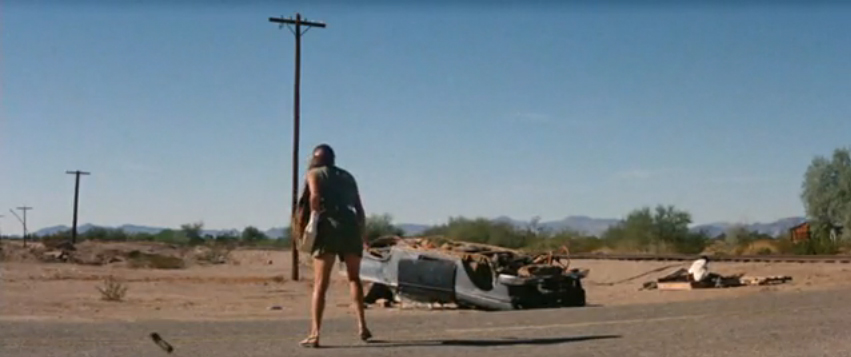
370 We see the auto from the rear, license plate HDJ 506. The interior of the decrepit shell of an auto is a bright red. Daria opens the car door and 7 push out past her, the other children who had accosted her disappearing into the distance across the road.

DARIA: Hey, come back!
CHILD: No!
She yells at them to come back but they yell no and, laughing, continue on across the railroad tracks. She approaches the boy in the white t-shirt, Olympia lettering on its back, and asks, "Hey kid, where's Jimmy?" He simply looks at her and mutely returns to plucking at the piano.

371 Medium shot from the left of the boy plucking the strings of the piano.
DARIA: Hey, kid, where's Jimmy?
His refusal to answer her is not very different from the old man in the bar who only shrugged his shoulders but didn't speak in response to her query. At the end of this section, Daria fleeing the scary place of Ballister, Antonioni will zoom in on that old man again, through a window of the Rumpus Room which shows an Olympia beer sign.
372 Medium shot of Daria facing screen left, then walking off screen left toward the RR tracks. The camera pans down to the boy plucking on the strings.
373 Daria approaches a raised platform to which she'd seen the children run behind, perhaps all that remains of what was once a building.

The stair rails leading up to the platform echo the stair rails observed in the security monitor at the Sandy Dunes building before Daria meets Lee.
The boy plucking at the strings of the deconstructed piano, the keys laying to the side, also refers us back to that scene, those keys echoing the keys on the security guard's belt and the mention of the "key" in the sign outside the window.
374 View of the children behind the platform, clambering up onto it and approaching Daria who has also climbed it.
375 Medium shot of a boy in a red shirt and one in a gray shirt at the base of the platform. They also climb upon it.
376 Two other boys climb upon the platform.
377 Two boys come running from elsewhere to join the others.
378 Daria on the platform now surrounded by about 12 boys,
none of whom is likely over the age of ten.
DARIA: Where's the man who brought you here? Doesn't he stay with you?
379 Medium shot of boy in gray shirt amongst the others.
BOY IN GRAY SHIRT: Can we have a piece of ass?
DARIA (laughing): Are you sure you know what to do with it?
One could call an ass a rump, which ties in with the Rump-us Room, though rumpus is not known to come from rump, instead believed possibly to come from robust, originally "oaken", being also a special kind of oak named for its reddish heartwood.
380 Another medium to close-up shot of the boys gathering around her.
BOY WITH RED HAIR: Yes.
381 The boys all congregated around Daria, the desert beyond.
DARIA: What are you doing?
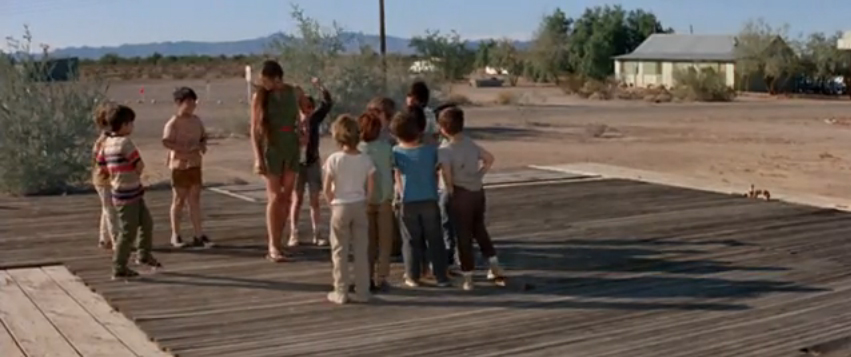
One boy communicates with the others by making a fist (the same as the fist in the Strike sign, held sideways, not a Black Panther fist) and drawing it down, then deliberately, slowly points a finger down then up. We hear him say, "Down." In response, the boys crowd upon Daria.
382 View from Daria's right side of the boys crowding upon her.
As they push and pull on her, grabbing at her dress, she flees.
383 Medium close-up of the boys pressing upon her.
384 Close-up of Daria's dress pulled to the side showing her underwear.
385 Medium shot of Daria extricating herself and fleeing the platform, the majority of the boys fighting with each other on it.
Now to look at some of the patterns here and see how they connect with some other things in the film. I've discussed already how we had the breaking glass and then the owner going outside and tossing a bottle across the road, it exploding on the pavement, which referred back to the mechanic dropping the bottle in the gutter outside the market next the airport. During that scene with the mechanic, just beyond there was seen a hitchhiker with his thumb pointed up. We had a dialogue of signs, some with text and those without. 7-up paired with the man with his thumb pointed up. Then we had an opposition with the man who conspiculously drops his bottle. But we can see also that it links with the later blow-up, explosion, with the exploding glass.
Here, we have the 7 boys who had spilled out of the upside down car, running over to this platform, and Daria following them. We have a boy speaking to the others with signs. He makes the sign of the fist (strike sign) and then points a finger up and then down, whereupon she's attacked.
The scene reminds of Barbarella where Jane Fonda is attacked by the children who set their razor-teeth doll on her, only Fonda's character was in real danger, whereas Daria manages to easily get away, the kids instead tumbling over each other, already distracted from her as she leaves the platform, only one following.
386 View from behind Daria's car of her running toward it.
387 Daria climbs into the driver's seat and we see the Rumpus Room beyond.
The Tennessee Waltz still plays as she, freaked out, drives off. The camera closes in on the windows of the Rumpus Room, one painted, "Pool Room" and the red circle of an Olympia beer sign beneath ("On tap, Olympia, It's the water") and a "Lucky Draft" sign in the other.
If we return to shot 349 wherein the owner's head is framed by red neon that I said reminded me of the circlets of radishes in the salad bowl ad, we realze it was another Olympia sign, and that the radishes are likely intended to expressly refer to this, else they'd not be hollowed out to be red rings. Not only that, but the colors of the Rumpus Room, the green exterior and the red neon, recall the "salad" in the bowl.
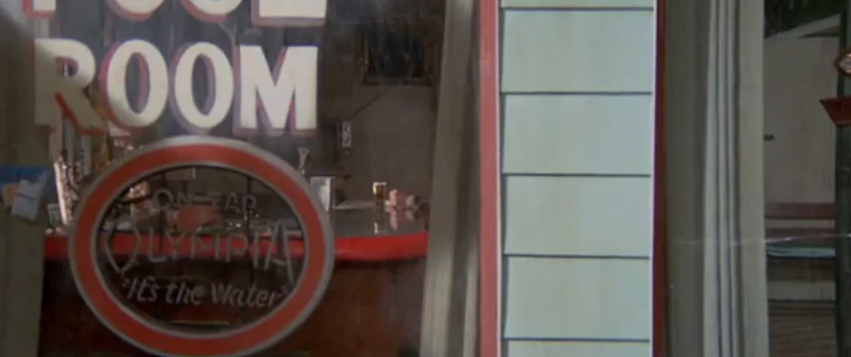
Zoom in through the window to the old fellow in the plaid shirt and cowboy hat who she Daria had first spoken with, he lifting a new beer to his mouth, seemingly oblivious, or deliberately oblivious to anything going on around him. The scene closes with the end of the Tennessee Waltz.

One is likely supposed to feel empathy for the youth culture, yet here we have children who have been supposedly rescued from Los Angeles by one of Daria's friends but who seem to have been given no guidance in their new home, virtually abandoned there, and have formed a little gang of tyrants while James Patterson is off perhaps meditating somewhere. This scene seems a replay of the protesters, the strike and the shooting. A different place, different circumstances, different individuals, but motifs inconspicuously link events, different cultural and age groups in conflict, past, present and future in strife, and perhaps "speaking" dialogue is absent, but patterns are certainly in dialogue.
(Note: Thanks to WRomanus for pointing out it was Ballister that Daria lands in. I had misheard and originally had Hallister.)
Via the siting of the pole reading Old Parker Road, and finding it and an intersecting road that crosses a nearby RR, we see the scene was shot at approximately 7500 U.S. 95 in Vidal, California.
View Larger Map
Approaching it by Interstate 10, Vidal is about 4 hours from LA, not too far a jog off I-10 to the north, on Highway 95. It's about 3 hours from Phoenix. It seems very plausible that this is the route Daria would have taken on her way to Phoenix, and that she would have taken this short detour in search of Patterson and Ballister. But after Daria landing in this fictitious ghost town, she ends up in Death Valley at Zabriskie Point, which is 5 hours to the north.
As for the use of Patti Page's version of Tennessee Waltz, considering Antonioni's use of doubles and aliases, such as Daria playing Daria and Mark playing Mark, I wonder if one of the reasons this song was used was because it was one of the most famouse songs (so says Wikipedia, I guess of its time) which used overdubbing, so that we have multiple Patti Pages singing. I don't know about that assertion but we do know this.
Mercury in the late 1940s was the domain of legendary pop producer Mitch Miller. Miller was a technical wizard, partial to the new technique of overdubbingaying one track over anotherhat enabled Page to sound like she was harmonizing with herself...
Source: enotes
Approx 9000 words or 18 single-spaced pages. A 70 minute read at 130 wpm..
Next: Part Four
Zabriskie Point TOC
Link to the main TOC page for all the analyses
